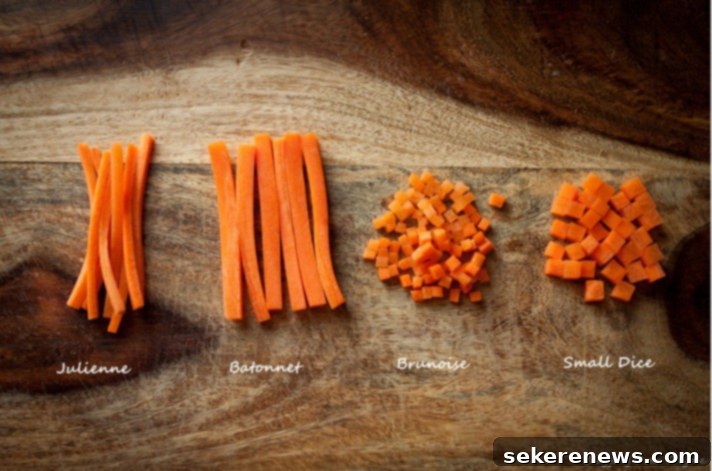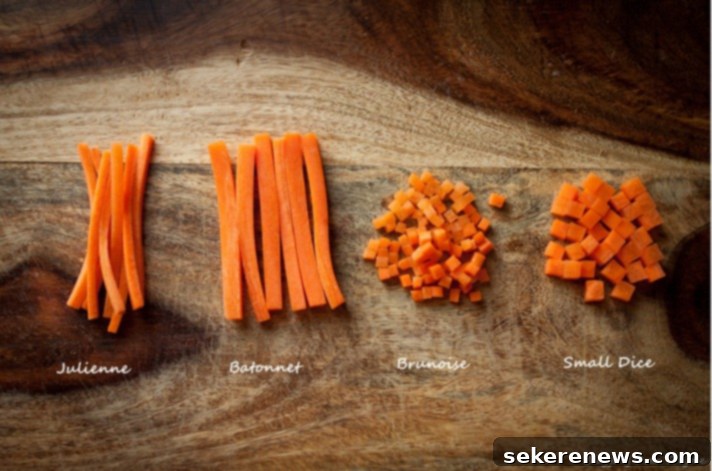Mastering Culinary Foundations: Knife Skills, Tournéeing, and Acing Your Culinary Exams
The scent of fresh vegetables and a hint of nervous energy currently fill my kitchen. This isn’t just a regular cooking session; it’s a high-stakes practice ground. Right now, I’m deep in the trenches, perfecting my knife skills with intense focus, simultaneously tournéeing my third bag of potatoes in a mere two days. Every cut, every turn of the potato, is a step towards readiness for what lies ahead: my first practical and theory exam, which is quite literally tomorrow!
The Unsung Hero: The Culinary Knife and Its Mastery
In the culinary world, the knife is an extension of the chef’s hand, and mastering its use is arguably the most fundamental skill one can acquire. It’s not just about slicing and dicing; it’s about precision, efficiency, and safety. A truly sharp knife, wielded with confidence, makes cooking a pleasure, not a chore. My current practice involves endless repetitions of various cuts, each designed for a specific purpose and presentation.
We start with the basics: the proper grip, the rocking motion, and the all-important claw hand to protect our fingers. From there, we dive into the specific cuts. There’s the humble but critical julienne, thin matchsticks often used for garnishes or quick-cooking vegetables. Then comes the brunoise, a tiny, perfect dice that evolves from the julienne, showcasing exceptional knife control. The small, medium, and large dice are bread and butter for countless recipes, demanding consistency in size for even cooking. And let’s not forget the delicate chiffonade for herbs, a technique that requires thinly slicing stacked leaves.
Each of these cuts serves a unique purpose, affecting not only the aesthetics of a dish but also its texture and cooking time. Consistent cuts ensure that all ingredients cook at the same rate, preventing some pieces from being overcooked while others remain raw. This level of consistency is a hallmark of professional cooking and a key criterion for any culinary practical exam. The hours spent on these seemingly simple tasks are invaluable, building muscle memory and refining the eye for detail.

The Art of Tournéeing: Sculpting Potatoes into Perfection
Beyond the standard cuts lies the more artistic, yet equally demanding, technique of tournéeing. This involves shaping a vegetable, most commonly a potato, into a seven-sided, barrel-like or football shape. It’s a classic French technique that elevates presentation and ensures even cooking, especially for dishes like pommes tournées.
Why spend so much time shaping a potato when a simple chop would suffice? The answer lies in the pursuit of culinary excellence. Tournéeing demonstrates a chef’s skill, patience, and dedication to tradition. It transforms a humble ingredient into something elegant and uniform. For an exam, it’s a direct assessment of knife control, dexterity, and attention to detail under pressure. Each potato requires precise, sweeping cuts to achieve those seven perfectly rounded sides. It’s a dance between the knife and the vegetable, demanding a steady hand and a keen eye.
My kitchen counter is currently littered with various stages of potato transformations – some perfectly shaped, others, well, lessons learned. The repetition is key; each potato offers an opportunity to refine the angle, the pressure, and the flow of the cut. It’s surprisingly meditative, despite the underlying pressure of the impending exam. This technique, though seemingly old-school, teaches invaluable lessons in precision that translate to many other areas of cooking.
The Crucible: Preparing for Practical and Theory Exams
Culinary school exams are unique. They aren’t just about memorizing facts; they’re about performing under pressure, demonstrating both theoretical knowledge and practical skill. Tomorrow’s exam will be a comprehensive test of everything we’ve learned so far.
The practical component will likely involve a series of timed tasks: executing specific knife cuts, preparing a particular dish or component, and demonstrating proper sanitation and mise en place. This is where the hours of knife practice and potato tournéeing will either pay off or reveal areas needing more work. Speed is important, but never at the expense of precision or safety. The examiners will be looking for clean workstations, organized movements, and, of course, perfectly executed culinary techniques.
The theory exam, on the other hand, will delve into the science and principles behind cooking. This could cover anything from ingredient identification, food safety regulations, culinary terminology, cooking methods, and even the history of various cuisines. It’s a reminder that cooking is not just an art, but also a science built on foundational knowledge. Understanding why certain ingredients react in specific ways, or the optimal temperature for particular cooking methods, is crucial for problem-solving and innovation in the kitchen.
The preparation for both aspects is intense. Flashcards for theory, endless repetitions for practicals, and constant review of notes and demonstrations. The pressure is palpable, but it’s also exhilarating. This is what we signed up for – to be challenged, to grow, and to transform our passion for food into a professional skill set.
Embracing the Culinary Journey: More Than Just an Exam
This journey through culinary school is a testament to dedication and the relentless pursuit of perfection in a craft that continually inspires. It’s about more than just passing an exam; it’s about building a solid foundation upon which a lifelong career in food will be built. Every mistake is a learning opportunity, every perfectly executed technique a small victory. The kitchen, whether at school or at home, transforms into a laboratory, a studio, and a stage all at once.
The skills being honed today – the precise knife cuts, the elegant tournée, the foundational knowledge – are the bedrock for more complex culinary endeavors. They empower a chef to approach any recipe with confidence, to improvise when necessary, and to create dishes that are not only delicious but also visually stunning and consistently excellent. This continuous learning, the pushing of one’s own boundaries, is truly the essence of the culinary profession.
Looking Ahead: The Exam and Beyond
As the clock ticks down to tomorrow, there’s a mix of apprehension and eager anticipation. I’ve put in the hours, sacrificed countless potatoes, and reviewed endless notes. All that’s left is to perform. I’ll be back tomorrow with a full update of today’s fabulous menu – which, despite the pressure, still managed to be delicious – and some much-anticipated scoop on how the exam went. Here’s hoping it all goes smoothly, and that all the hard work translates into a successful outcome!
Wish me luck, and stay tuned for the results of this exciting culinary challenge!
